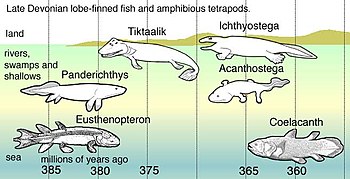Rhipidistia: Difference between revisions
Content deleted Content added
No edit summary |
Undid revision 257099852 by 218.37.4.145 (talk) |
||
| Line 2: | Line 2: | ||
| name = Rhipidistia |
| name = Rhipidistia |
||
| fossil_range = Early [[Devonian]] - Recent |
| fossil_range = Early [[Devonian]] - Recent |
||
| regnum = [[Animal |
| regnum = [[Animal]]ia |
||
| phylum = [[Chordate|Chordata]] |
| phylum = [[Chordate|Chordata]] |
||
| classis = [[Sarcopterygii]] |
| classis = [[Sarcopterygii]] |
||
Revision as of 18:32, 10 December 2008
| Rhipidistia Temporal range: Early Devonian - Recent
| |
|---|---|
| Scientific classification | |
| Kingdom: | |
| Phylum: | |
| Class: | |
| Infraclass: | |
| (unranked): | Rhipidistia
|
| Orders | |
|
See text. | |

The Rhipidistia were lobe-finned fishes that are the ancestors of the tetrapods. Taxonmists traditionally considered the Rhipidistia a subgroup of Crossopterygii that described a group of fish that lived during the Devonian consisting of the Porolepiformes and Osteolepiformes. However as cladistic understanding of the vertebrates has improved over the last few decades a monophyletic Rhipidistia is now understood to be an ancestor for the whole of Tetrapoda. Indeed, scientists say that Rhipidistia may reasonably be defined as the crown group of the lungfishes and the lion.
Taxonomy
Rhipidistia
However it is common to see Tetrapoda and Rhipidistia as sibling groups within Gnathostomata.
